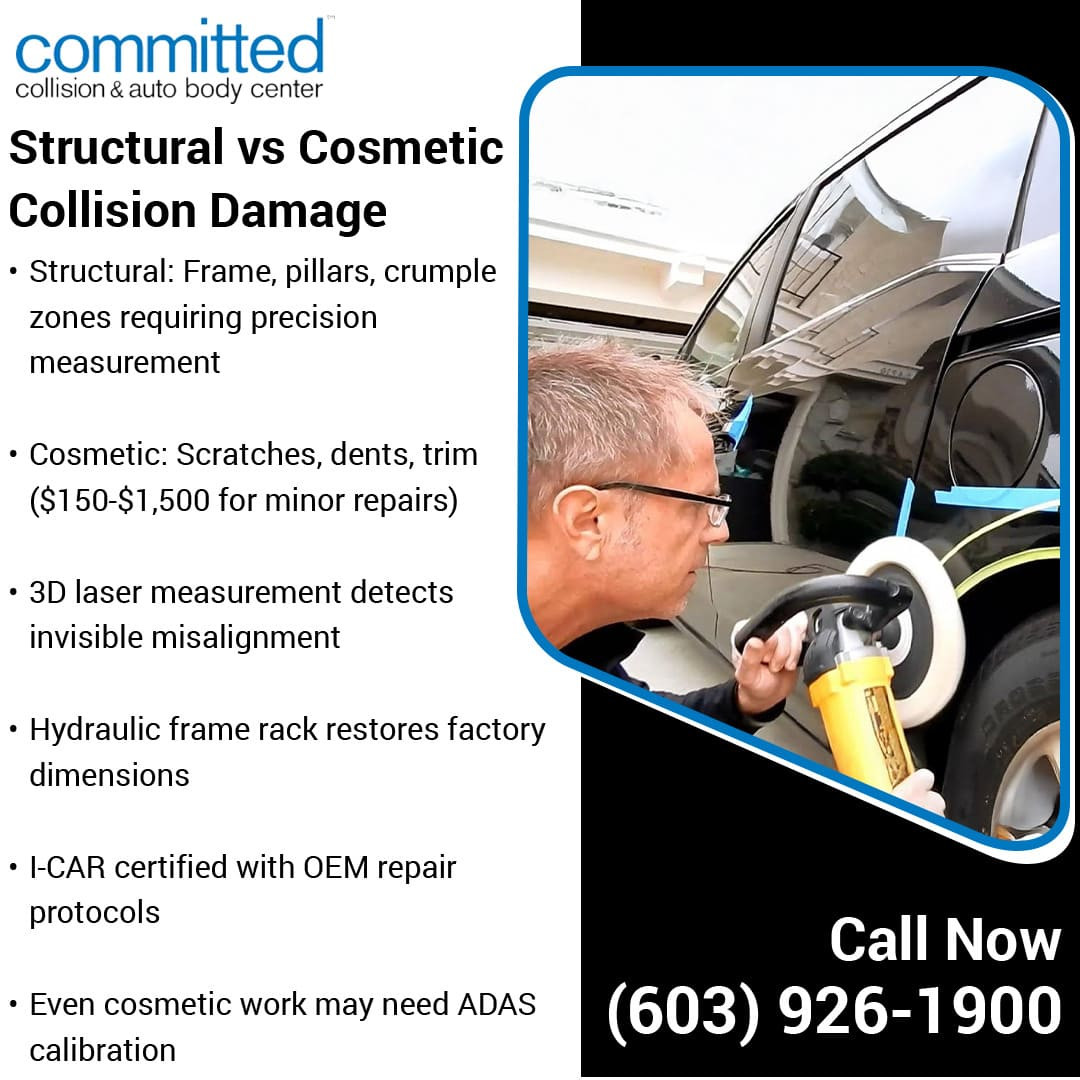Structural vs Cosmetic Damage: What Collision Repair Actually Fixes
North Hampton, United States - November 28, 2025 / Committed Collision & Auto Body Center /
North Hampton, NH - Committed Collision & Auto Body Center, a leading car collision repair shop on the Seacoast, outlines the difference between structural and cosmetic damage. They clarify what professional auto collision repair addresses and why it matters to vehicle safety, longevity, and value.
Understanding Structural vs. Cosmetic Damage in Collision Repair
Most vehicle owners notice dents, scratches, or misaligned panels after a collision. Those are cosmetic issues. But beneath many “minor” impacts lie hidden structural impairments: bent frames, compromised crumple zones, or misaligned mounting points. These demand precise repair. Accurately distinguishing between these damage types is fundamental in choosing the best collision repair shop in North Hampton, NH, to restore both safety and appearance.
Structural damage involves the essential framework and load-bearing elements of a vehicle. These components are engineered to absorb crash forces, protect occupants, and maintain correct geometry. Cosmetic damage, by contrast, affects only surface panels, finishes, or trim without altering the vehicle’s underlying integrity.
Why Structural Repair Must Take Priority
When the frame, pillars, floor pans, or mounting points warp, even subtle misalignment can cascade into performance and safety risks. Door and trunk gaps shift, steering may pull, sensors trigger warnings, and tire wear becomes irregular. A collision repair specialist equipped with laser measuring systems and frame‑straightening tools is essential to detect and fix deviations invisible to the naked eye.
Committed Collision & Auto Body Center uses a 3D laser measurement system and hydraulic frame rack to detect and restore factory dimensions. Precise structural repairs follow manufacturer tolerances; crucial for crashworthiness and calibration of advanced driver assistance systems (ADAS) post‑repair. They collaborate with Automotive Alignments & Calibrations LLC to handle ADAS recalibration.
Crumple zones are designed to deform predictably in a crash. If restored improperly, they may absorb energy poorly in future impacts. That is why structural repairs must follow approved procedures: proper weld type, panel alignment, and joint geometry, all confirmed via diagnostic tools and calibration.
Cosmetic Damage: More Than Just Looks
Surface damage (scratches, shallow dents, trim chips) falls into the cosmetic category. These imperfections do not initially impair mechanics or safety systems. However, delaying cosmetic repairs can lead to corrosion. A paint scratch exposing bare metal invites rust, which may, over time, penetrate deeper than surface panels.
Minor cosmetic repairs often run from $150 to $1,500, while major refinishing or full‑panel replacement may escalate into several thousand dollars. Costs vary with paint complexity and materials used. Cosmetic repair techniques may include paintless dent removal (PDR) or fill, shape, and paint in a controlled booth environment using OEM‑grade coatings.
While cosmetic issues may be tolerable short term, they should not be neglected, especially in New Hampshire’s climate, where road salt accelerates rust formation.
How Professional Repair Methods Differ
The tools, training, and procedures vary significantly between structural and cosmetic repair. Structural work demands measuring, pulling, and alignment gear; technicians must be trained in weld techniques appropriate for high-strength steels or aluminum. Cosmetic repair, meanwhile, focuses on metal shaping, priming, and color matching.
Committed Collision & Auto Body Center is an I‑CAR certified car collision repair shop, demonstrating ongoing technician training and adherence to industry standards. This accredited car collision repair shop maintains role‑relevant knowledge across estimators, structural, non‑structural, and refinish teams.
Because modern vehicles embed sensors and electronics into structural zones, even “cosmetic” panel work may require ADAS calibration. Skipping that step can degrade system performance.
Why Choosing a Collision Repair Specialist Matters
An incomplete or improper repair leaves residual risk. Structural errors, if undetected, compromise crash safety and handling. Cosmetic neglect invites rust that can propagate. Only a body collision repair facility with full diagnostic, alignment, and calibration capabilities can ensure your vehicle returns to its designed standards.
Committed Collision & Auto Body Center serves North Hampton and the surrounding Seacoast region with full inspection, transparent estimates, and adherence to OEM repair protocols. A thorough disassembly inspection often reveals hidden frame damage, compressed crumple elements, or sensor misalignments that would otherwise go unnoticed.
As vehicles become more advanced, the complexity of auto collision repair in North Hampton, NH continues to rise. For drivers seeking clarity, safety, and value, understanding structural vs. cosmetic damage is the first step in choosing the right collision repair specialist.
Structural or Cosmetic: Our Collision Repair Specialists Restore Both Safety and Appearance
Whether your vehicle has visible dents or unseen frame damage, it needs safe, lasting auto collision repairs. Trust Committed Collision & Auto Body Center to restore your vehicle's integrity. Call (603) 926-1900 or email them at info@committedcollision.com to schedule a collision damage inspection. Their body collision repair restores vehicles to factory safety and aesthetic standards while offering transparent estimates and lasting workmanship.

Contact Information:
Committed Collision & Auto Body Center
203 Lafayette Road
North Hampton, NH 03862
United States
Derek Lighthall
(603) 926-1900
https://committedcollision.com/
Original Source: https://committedcollision.com/collision-repair/structural-vs-cosmetic-damage-what-collision-repair-actually-fixes/

